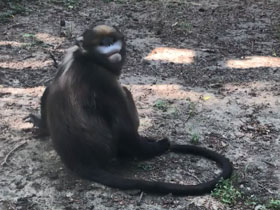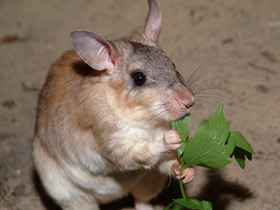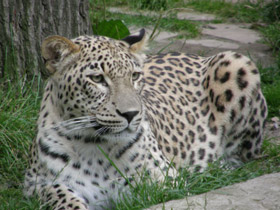The gray snub-nosed monkey (Rhinopithecus brelichi), Brelich's snub-nosed monkey, Guizhou snub-nosed monkey, and Guizhou golden monkey
Gray Snub-nosed Monkey видео
The gray snub-nosed monkey (Rhinopithecus brelichi), also known as Brelich's snub-nosed monkey, Guizhou snub-nosed monkey, and Guizhou golden monkey, is a species of primate in the family Cercopithecidae. It is endemic to China, where it is known as the Guizhou golden hair monkey (黔金丝猴) or gray golden hair monkey (灰金丝猴). It is threatened by habitat loss. Of the three species of snub-nosed monkeys in China, the gray snub-nosed monkey is the most threatened, with a total population thought to number fewer than 400 individuals.
Description
Adult animals are covered with long, dense wool; the upper part of the body is brown, while the lower part is grey. There is a light spot between the shoulder blades. Head, neck, feet and palms of the hands are black, eyebrows golden. Chest also golden, brown on the inside of the extremities. The face is hairless, the skin of the face is light blue, around the eyes and mouth is pink. The brow ridge is pronounced and the nose is flat. The young are born grey and become adults with age.
Males have a shinier coat than females. Males weigh 14.5 kg on average and females 8 kg on average. Body length varies between 64-73 cm and tail length between 70-97 cm.
Distribution
The confirmed distribution range of the gray snub-nosed monkey is limited to the Fanjingshan National Nature Reserve in the Wuling Mountains in Guizhou province, China. There is unpublished evidence that 20 individuals moved from the Nature Reserve to an adjacent community forest (Lijiadashan), and there are unconfirmed anecdotal reports of a population in Jinfoshan Nature Reserve.
Habitat
Its habitat consists of mixed deciduous and evergreen broadleaf forests, including secondary forest, but not coniferous forest. The forests include mono-groves of Asian oak (Cyclobalanopsis spp.) and beech (Fagus longipetiolata), as well as mixed species forests that include cherry (Prunus spp.), maple (Acer spp.), Rhododendron spp, and birch (Betula spp.) trees. It lives at elevations of 1,400–2,300 m in summers down to 570 m at times of heavy snow cover. They are thought to utilize most of the available range of the nature reserve. The yearly rainfall in the area above 1,600 m elevation is above 2000 mm. Snow is common in the winter, with sub-freezing temperatures about five months of the year, though monthly mean temperatures are never below 0 °C.
Behavior
The diurnal species is considered semi-terrestrial, primarily inhabits trees where available. Locomotion includes a mix of "quadrupedal walking, climbing, leaping, semi-brachiation (tree-swinging) and occasional full brachiation."
It feeds on a variety of young leaves, leaf and flower buds, bark, fruits, certain petioles (e.g. Fagus longipetiolata), seeds (e.g. Prunus spp. and Sorbus spp.), and insect larvae. Seasonality of the forest means the monkey's diet changes seasonally as well; it may be 7% leaves in the first three months of the year, and 93% in the next three. Fruits and seeds can constitute 35% of the diet in July to September.
Its social structure is based on small groups that band together into larger troops of up to 400 or more individuals, traveling, feeding and sleeping. The groups typically have 5–10 members, comprising one dominant male and several females and their young. There are also all-male bachelor groups of two to five adult or sub-adult males, which typically mill about the periphery of a troop. The groups split into large or smaller bands seasonally.
Conservation status
Though legally protected, the gray snub-nosed monkey is threatened seriously due to habitat loss from forest clearing, illegal mining, non-targeted hunting, and occasional inadvertent snare trapping. A 2008 census located around 750 individuals, consistent with a 2005 census. The estimated number was reduced in 2020 when a study on the remaining habitat estimated there may be as few as 125 to 336 individuals. In 1978, the Fanjingshan National Nature Reserve was established, covering the entire range of the gray snub-nosed monkey, this area was subsequently designated a UNESCO Biosphere Reserve in 1986. In 2018, Fanjingshan was designated a World Heritage Site composed of Fanjingshan National Nature Reserve, Yinjiang Yangxi Provincial Nature Reserve, and a small area of National Non-Commercial Forest.











































